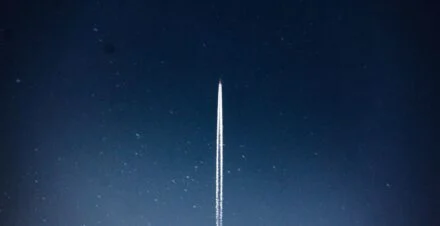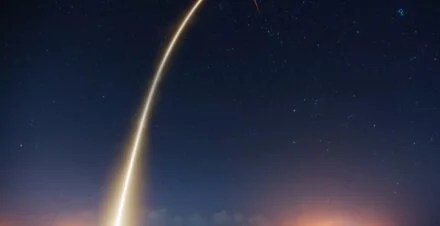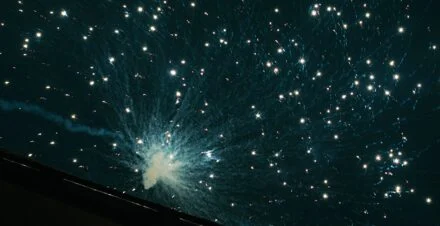Short on time? Listen to this article on-the-go.

In 2019, there were 800 functional satellites in low Earth orbit. Now, there are over 5,000.
That exponential growth makes even the most seasoned space veteran say, “Wow.”
And remarkably, the industry is just getting started.
Understandably, this is causing some to ask, “Are we running out of space in space?” This fear is compounded by the number of debris left behind during the previous six decades of space operations. It’s true: we’re in a uniquely challenging collision risk environment. However, while this is certainly a cause for serious reflection, it’s not a cause for panic. This momentous period in the space economy doubles as a rare opportunity to examine how the previous space era mixes with the new, and to use innovative thinking and collaborative problem-solving to preserve LEO for future generations.
Demystifying low Earth orbit, one data point at a time
To combat fear and confusion, we must first address the feeling of mystery around LEO and the estimated hundreds of thousands of space objects (and debris) that fill this seemingly shrinking realm. And that’s exactly what we aim to do.
With help from the team of analysts and engineers at LeoLabs, we’ll use the data collected by our global network of phased array radars to “demystify” LEO for you. Every quarter, we’ll review what’s happened and help answer the questions wracking your brain, like: “What’s more dangerous to operational satellites today? Constellations or debris?” and “Which regions have the greatest collision risk now? Or might in the future?”
As you read through LeoPulse, we hope a few aspects of the solutions necessary for tracking and managing the growing traffic in LEO become clearer. Just like safer driving or flying here on Earth, safe operations in LEO requires responsible behavior, sound analytic assessments, transparent communication and effective regulation.

From the ground up: an in-depth look at the traffic in LEO from June to September 2022
Moving forward, our quarterly reports will examine three primary components of the LEO population: “Clouds,” “Clusters” and “Constellations,” with a bonus section called “Bad neighborhoods.” Each of these sections will be updated with data and insights relevant to satellite operators, regulators, and others concerned with STM and SSA.
— Skip to: Clouds | Clusters | Constellations | Bad neighborhoods —
Clouds
Over 250 objects have fragmented in LEO over the last 60 years. These events create “clouds” of fragments that spread rapidly across large volumes in space. Today, three major collision-induced clouds dominate the LEO environment: Fengyun 1C, COSMOS 1408, and COSMOS 2251. Fragments from these events spread hundreds of kilometers in altitude and likely contributed tens of thousands of additional lethal but currently non-trackable fragments (smaller than 10 cm).
From June to September 2022, the number of COSMOS 1408 debris fragments in orbit continued to decrease (from ~600 to ~500) because of atmospheric drag cleansing them from orbit. This decrease, however, didn’t lead to a decrease in monthly dangerous (PC > 1E-6) conjunctions: ~2,500 occurred in June and ~3,000 were monitored in August. This highlights the fact that collision risk in LEO is dependent on many factors beyond the number of objects in orbit. In the past, many of the COSMOS 1408 conjunction events occurred in bunches (described as “squalls” by Dan Oltrogge of COMSPOC). We observed a squall in mid-August, which led to the conjunctions mentioned above.
Overall, during this last quarter, we observed that out of the ~107,000 high-PC encounters in LEO, ~47,000 involved fragments from ten clouds of debris that have more than 150 fragments still in orbit. Put simply, roughly 45% of dangerous events observed during this period involved remnants from just ten breakup events.
Key takeaways:
- Three collision-induced clouds dominate LEO: Fengyun 1C, COSMOS 1408 and COSMOS 2251
- COSMOS 1408 debris fragments decreased from ~600 to ~500 due to atmospheric drag. However, the number of dangerous conjunctions involving COSMOS 1408 debris increased due to an increase in operational satellites
- Roughly 45% of dangerous events observed involved remnants from just ten breakup events

Clusters
During the first 45 years of the space age, massive derelict objects — from spent rocket bodies to non-operational payloads — were abandoned, creating a ticking time bomb of debris-generating potential. They currently account for nearly 75% of the total mass in LEO. We refer to them as “clusters” because these massive derelict objects are often abandoned in large numbers in similar orbits.
In a recent study led by LeoLabs, we identified the top 50 statistically-most-concerning objects in LEO. While 40 of these objects were abandoned before 2001, the Chinese government has abandoned four rocket bodies in the last decade alone. However, the most populous family of rocket bodies are the 285 Russian SL-8 rocket bodies littered throughout LEO. Over the last quarter, there were nearly 4,000 dangerous conjunctions involving at least one SL-8 rocket body and 41 conjunctions involving two SL-8 rocket bodies.
There were also 16 conjunction events involving two massive derelict objects (typically large, abandoned rocket bodies and defunct payloads) that totaled over 15,000 kg in combined mass. If any one of these dangerous crossings resulted in a collision, it would likely generate well over 15,000 cataloged fragments — nearly doubling the current catalog. Unsurprisingly, we observed that 13 of these events involved two SL-16 rocket bodies. For years they’ve been recognized as the most troublesome cluster in LEO because 18 of them reside within a 40 km altitude range.
Key takeaways:
- 75% of the total mass in LEO is currently made up of objects abandoned primarily during the first 45 years of the space age
- The most populous family of rocket bodies are the 285 Russian SL-8 rocket bodies; nearly 4,000 high-PC conjunctions involved an SL-8 rocket body

Constellations
Operational satellites are deployed more and more in large constellations, driving up space traffic management demands and collision avoidance needs. The locations of these deployments vary widely. Currently, nearly 25% of objects in LEO are operational payloads deployed in lower altitudes (i.e., below 1,300 km).
It should come as no surprise that SpaceX’s Starlink remains the largest constellation in LEO. In the last quarter alone, the constellation grew by several hundred to total just over 3,000 operational satellites. The spatial density (i.e., number of objects per cubic kilometer at 2.5E-7) is now the largest at the Starlink altitude (~550 km) than anywhere else in LEO.
At first glance this may seem concerning because spatial density is used to estimate the likelihood of a collision for uncontrolled objects. In the case of operational constellations, however, this is a bit misleading due to the synchronization of active, agile, and station kept satellites, which are distinctly different than a cloud or cluster of debris. It’s like considering the likelihood of a collision with a marching band on a football field versus a chaotic swarm of students after a big win.
Let’s look at the altitude of 840 km, for example. We consider this a “bad neighborhood” (more on that below) because while its spatial density is just 20% of the Starlink constellation (5.7E-8), it consists of a quagmire of breakup fragments, massive rocket bodies, and non-operational payloads. The mass density (number of kilograms per cubic kilometer) for this altitude is also a factor of three smaller compared to the Starlink altitude. What makes this altitude much more dangerous, however, is the fact that the derelict objects have no intent or capability to avoid collisions — constellations do.
Key takeaways:
- Nearly 25% of objects in LEO today are operational payloads deployed in lower altitudes (i.e., below 1,300 km)
- The spatial density at the Starlink altitude (~550 km) is now the largest than any place else in LEO, but spatial density is not an accurate measurement of collision risk between members of constellation

Bad neighborhoods
Let’s keep our attention on the “bad neighborhoods” of LEO. The prototypical “bad neighborhood” is 800 km to 900 km. This region consists of a mix of several significant breakup events and hundreds of abandoned derelict objects that together create the greatest debris-generating potential in LEO. However, the region from 950 km to 1050 km is also littered with hundreds of derelict objects, including ~160 SL-8 rocket bodies along with their ~160 payloads deployed over 20 years ago. There were 1,400 high-PC conjunctions involving these rocket bodies in the last quarter alone. Earlier in 2022, the riskiest conjunction event of the year occurred in this same “neighborhood” between COSMOS 2334 and COSMOS 2315, two non-operational payloads deposited in orbit over 25 years ago. The event between these two payloads occurred at ~1,000 km with a miss distance of 15 m and a probability of collision (PC) of 3%. Typical PC values of concern are much, much smaller than this, so that one made us sweat a bit.
Key takeaways:
- The region between 800 to 900 km has the greatest debris-generating potential in LEO due to Chinese fragments, abandoned Russian rocket bodies, and a combination of nonoperational payloads and fragments of American origin

Keep your eye on the sky: what’s coming up in LEO
What can we expect in the next quarter? Unsurprisingly, more satellites will launch into LEO. This includes satellites from SpaceX and OneWeb, as well as the Joint Polar Satellite System 2 (JPSS 2) by NASA and NOAA scheduled for early November.
In terms of legislative and regulatory activities related to LEO, the United States government is asking for support to propose a resolution at the United Nations General Assembly (UNGA) for states to commit “not to conduct destructive direct-ascent anti-satellite missile (ASAT) tests.” Prepare to see more discussion on this topic during the UN’s next Open-Ended Working Group on Space Threats (OEWG) meeting in January. Finally, in the last quarter, Japan, Germany, and New Zealand joined the US-led initiative to impose a self-ban on ASAT missile tests that create orbital debris. At the time of writing, both South Korea and United Kingdom have also joined the initiative, bringing the total number of countries to seven. Expect to see more countries follow suit in the coming weeks.
In addition, we expect to see more discussion (and some pushback) following the adoption of the Federal Communication Commission’s order to set a “five-year rule” for disposing satellites in LEO. It’s likely that we’ll also see potential movement from other governments with similar guidelines. This may be particularly true in the United Kingdom, which recently made significant movement towards demonstrating active-debris removal in orbit by awarding two Phase B demo contracts to ClearSpace and Astroscale. For more on why we think the “five-year-rule” is a good step forward, check out this WIRED article.
Finally, when it comes to Space Traffic Management (STM), you may have missed the agreement signed by the US Department of Defense and Department of Commerce in September to work together to achieve Space Policy Directive (SPD) 3. This directive calls for the development of a new national STM service managed by a civil government agency. As part of this initiative, LeoLabs was awarded a contract to help support the development of a US, civil-led STM prototype.
— Return to: Clouds | Clusters | Constellations | Bad neighborhoods —
More of a visual learner? We’ve got you covered. Download this infographic.
And that’s all for now folks!
Stay tuned for the 2nd edition of LeoPulse coming out in mid-November which will feature a thought leadership piece from our team. If you haven’t signed up for our newsletter yet, please do so you don’t miss the next edition. Do you have suggestions about what we should cover in the next quarterly review (scheduled for January 2023)? Let us know by emailing our editor Victoria Heath at vheath@leolabs.space with the subject line: LeoPulse suggestion.
Ad astra!
Note: The findings shared in this report and infographic are derived from the hundreds of thousands of data products LeoLabs’ global network of phased array radars collects daily.
Photo credit: Matthew Shouppe (Senior Director of Insights & Partnerships, LeoLabs)









